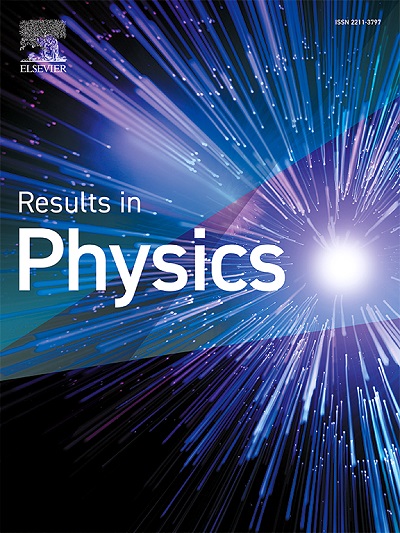微观结构极性流体中的生物对流:非奇异非局域核分数传热传质模型
IF 4.4
2区 物理与天体物理
Q2 MATERIALS SCIENCE, MULTIDISCIPLINARY
引用次数: 0
摘要
生物对流发生在微生物生长受对流流影响的工作流体中。了解这些流体的流动行为对于许多生物和环境过程至关重要,例如水的净化、药物输送和微生物生态。本文探讨了垂直平板上的生物对流流动,涉及具有质量和热量传递的微极流体。首先,采用偏微分方程(PDEs)来表达问题,该方程使用非奇异非局部核来考虑系统对内存的影响。利用拉普拉斯变换技术,求出既满足控制方程又满足特定条件的解,并用图形表示出问题的精确解。强调了在热边界层模拟中考虑变普朗特数的重要性。当粘度和热导率取决于温度,处理普朗特数作为一个变量是准确的结果至关重要。具体来说,随着热导率参数的增加,所研究的边界层内的速度和温度会更高。了解质量施密特数的影响在各种实际应用中至关重要,例如化学工程过程,其中精确控制传质对于优化微极流体系统中的反应和产品质量非常重要。当施密特数增加时,意味着动量扩散(粘度)占主导地位,而不是质量扩散,导致物质在流体中的扩散更慢。像ABC算子这样的分数阶导数的一个关键优势是它们能够模拟系统中的记忆效应,在系统中,过去的状态会影响当前的行为。这在控制理论、神经动力学、流体动力学和金融等领域尤其重要,因为历史数据会影响未来的行为。工程利益量也被计算并以表格形式显示。本文章由计算机程序翻译,如有差异,请以英文原文为准。
Bioconvection in polar fluid with microstructure: A fractional heat and mass transfer model with non-singular and non-local kernel
Bioconvection flows occur in working fluids where the growth of microorganisms is subject to convective flows. Understanding the flow behavior of these fluids is essential for many biological and environmental processes, such as the purification of water, drug delivery, and microbial ecology. This article explores the bioconvection flow over a vertical flat plate, involving a micropolar fluid with mass and heat transfer. In the beginning, partial differential equations (PDEs) are used to formulate the problem, which use a non-singular and non-local kernel to take into consideration the memory impacts of the system. The problem is formulated and exact solutions are obtained by using the Laplace transform technique, finding solutions that satisfy both the governing equations and specific conditions, and then representing these solutions graphically. The statement highlights the importance of considering variable Prandtl number in thermal boundary layer modeling. When viscosity and thermal conductivity depend on temperature, treating Prandtl number as a variable is crucial for accurate results. Specifically, as thermal conductivity parameter increases, it leads to higher velocities and temperatures within the boundary layers being studied. Understanding the effect of mass Schmidt number is essential in various practical applications such as chemical engineering processes, where precise control of mass transfer is important for optimizing reactions and product quality in micropolar fluid systems. When Schmidt number increases, it means that momentum diffusion (viscosity) dominates over mass diffusion, causing species to diffuse more slowly in the fluid. One of the key advantages of fractional derivatives like the ABC operator is their ability to model memory effects in systems, where past states influence current behavior. This is particularly important in fields like control theory, neurodynamics, fluid dynamics, and finance, where historical data impacts future behavior. Engineering interest quantities are also calculated and shown in tabular form.
求助全文
通过发布文献求助,成功后即可免费获取论文全文。
去求助
来源期刊

Results in Physics
MATERIALS SCIENCE, MULTIDISCIPLINARYPHYSIC-PHYSICS, MULTIDISCIPLINARY
CiteScore
8.70
自引率
9.40%
发文量
754
审稿时长
50 days
期刊介绍:
Results in Physics is an open access journal offering authors the opportunity to publish in all fundamental and interdisciplinary areas of physics, materials science, and applied physics. Papers of a theoretical, computational, and experimental nature are all welcome. Results in Physics accepts papers that are scientifically sound, technically correct and provide valuable new knowledge to the physics community. Topics such as three-dimensional flow and magnetohydrodynamics are not within the scope of Results in Physics.
Results in Physics welcomes three types of papers:
1. Full research papers
2. Microarticles: very short papers, no longer than two pages. They may consist of a single, but well-described piece of information, such as:
- Data and/or a plot plus a description
- Description of a new method or instrumentation
- Negative results
- Concept or design study
3. Letters to the Editor: Letters discussing a recent article published in Results in Physics are welcome. These are objective, constructive, or educational critiques of papers published in Results in Physics. Accepted letters will be sent to the author of the original paper for a response. Each letter and response is published together. Letters should be received within 8 weeks of the article''s publication. They should not exceed 750 words of text and 10 references.
 求助内容:
求助内容: 应助结果提醒方式:
应助结果提醒方式:


